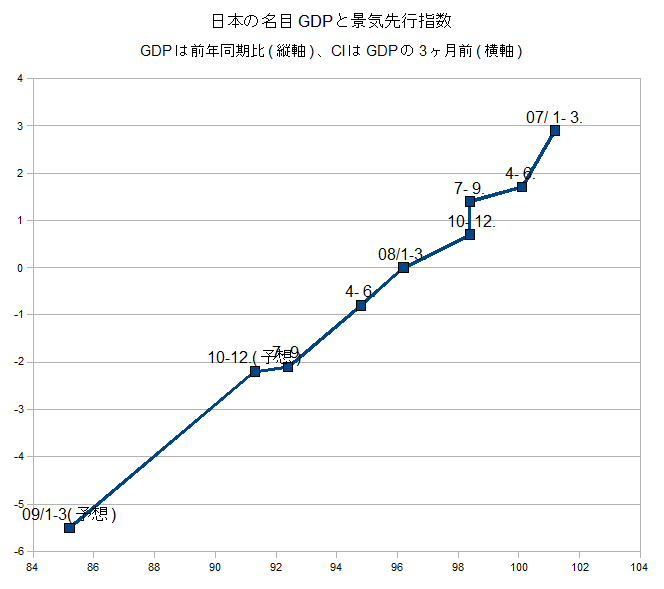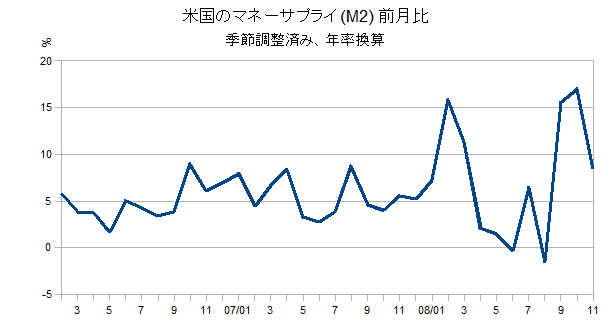2009-01-17
_ 日本の景気予想
ここ2年くらいの景気動向指数(CI,先行)と3ヵ月後の名目GDPをプロットしたらきれいな直線になりました。先行指数はすでに分かっているので、その直線を伸ばして08年10-12月(未発表)と09年1-3月の名目GDPを予想してみました。
ちなみに08年11月に発表された最新の CI は 81.5 です。どれだけひどくなるかを考えると、ちょっと恐くなってきます。
_ FRBが何をやろうとしているか
リッチモンドFRB理事のスピーチ。前に説明した、「中期での金融政策と足元の信用収縮への対策は違う。現在FRBのバランスシートの拡大は後者への対応」というようなことが書いてあります。
But monetary policy and credit programs do two different things. Monetary policy stabilizes the purchasing power of money over time by keeping the price level stable and relatively predictable, and by doing so, contributes to maximum sustainable economic growth. Credit policy is also aimed at promoting growth, but it is more a form of fiscal policy in that it uses the public sector's balance sheet to alter the allocation of resources.
バーナンキのスピーチでも「金利が0になっても期待に働きかけることで、金融緩和を実施します。それとは別に足元の金融市場の混乱を収めるためにバランスシートの拡大を使います」というようなことを言っています。
Other than policies tied to current and expected future values of the overnight interest rate, the Federal Reserve has--and indeed, has been actively using--a range of policy tools to provide direct support to credit markets and thus to the broader economy. As I will elaborate, I find it useful to divide these tools into three groups. Although these sets of tools differ in important respects, they have one aspect in common: They all make use of the asset side of the Federal Reserve's balance sheet. That is, each involves the Fed's authorities to extend credit or purchase securities.
「税金で○○○を救済します」と言うとものすごい政治的な抵抗が沸き起こります。けど、「財務省が債券を発行してそれをFRBが引き受けて、払った代金は財務省の口座に置いたままにして、債券の方は市場に放流して、得た資金を金融市場にぶち込みます」と言っても、なんだかよく分からないから、政治的な抵抗がおきません。うまい方法を考えたもんです。
とはいえ、現在のように金利がゼロで、FRBのバランスシートを見ても何やっているか説明されないとよく分からない状況で、FRBがどれくらい金融緩和をしたか(するつもりか)を伝える手段がないのは問題です。金利の引き下げは金融緩和の分かりやすいシグナルになっていましたが、今からは何を使うんですかねえ。ちょっと難しい。
- 19 http://pookmark.jp/url/fe93a04367eaee5fcac337449f2...
- 18 http://q.hatena.ne.jp/1157579848
- 12 http://www.yza.jp/blog/item/285
- 9 はてなアンテナ[mmasuda]
- 7 http://d.hatena.ne.jp/himaginary/
- 5 はてなアンテナ[arn]
- 4 はてなアンテナ[mintleaf]
- 3 http://blog.lucanian.net/archives/50823597.html
- 3 はてなアンテナ[yshl]
- 2 http://kjana.dip.jp/ant.html
- 2 http://d.hatena.ne.jp/himaginary/20090201
- 2 http://d.hatena.ne.jp/JunMitani/20080214
- 2 はてなアンテナ[svnseeds]
- 2 はてなアンテナ[svnseeds]
- 1 http://pdde312.dip.jp/nucleus/
- 1 http://kekonsoudanjo.seesaa.net/
- 1 http://kaoriha.org/dtp/dtp.htm
- 1 http://i-know.jp/dsl/
- 1 http://gigazine.net/index.php?/news/comments/20070...
- 1 http://b.hatena.ne.jp/umeten/favorite?of=50
- 1 http://b.hatena.ne.jp/tzr6063/
- 1 http://b.hatena.ne.jp/tenkoma/20080802
- 1 http://b.hatena.ne.jp/t/economics?sort=eid&of=50
- 1 はてなアンテナ[svnseeds]

